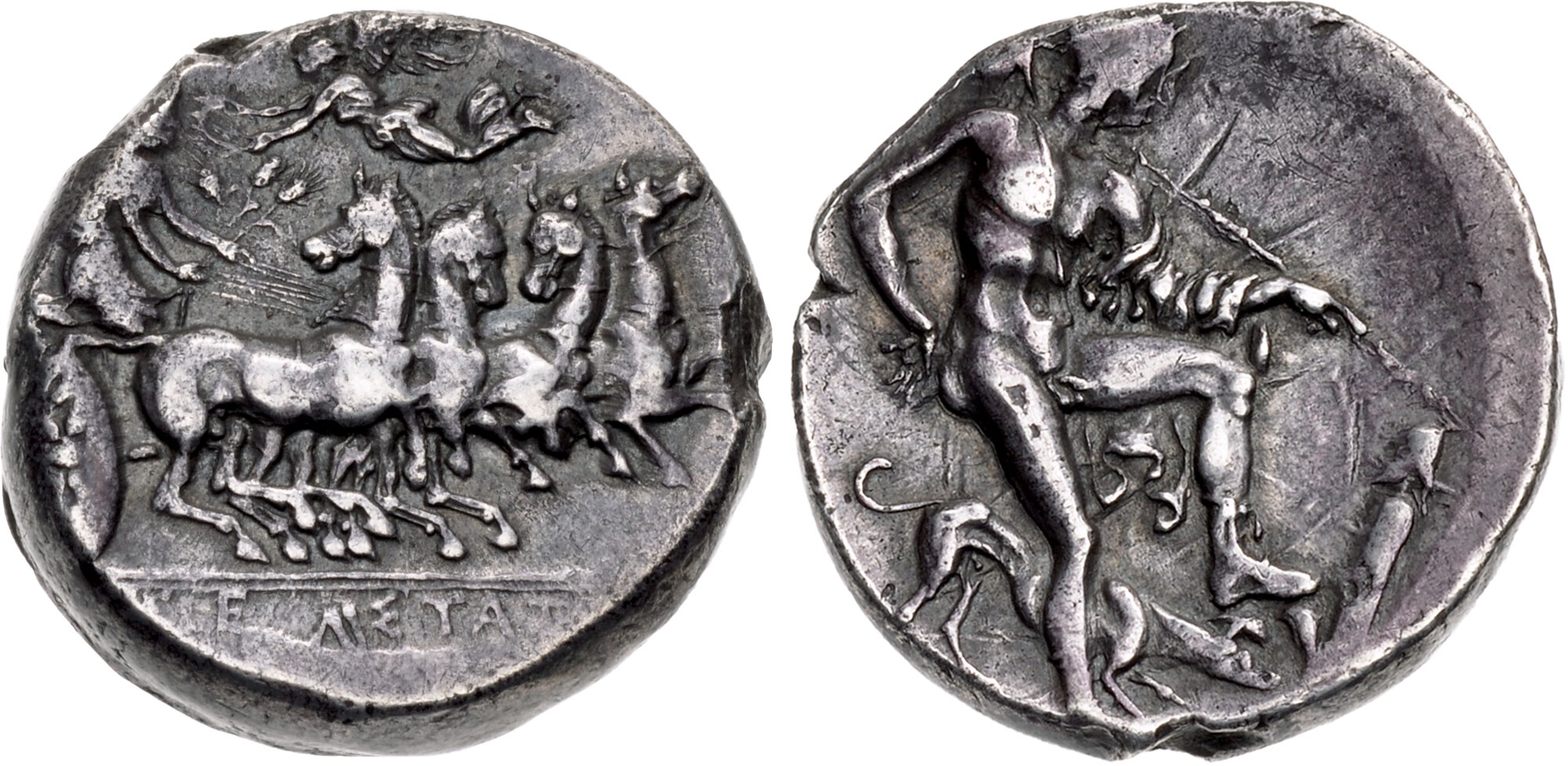Segesta, silver, tetradrachms (390-385 BCE)
From SILVER
390 BCE - 385 BCE Silver 334 kg
Description
| ObverseInscription or printing placed on the obverse.: | [Σ]E-ΛEΣTAZ[IA] above (Greek).Aigiste, holding grain ear in right hand and reins in both, driving fast quadriga right, above, Nike flying left, crowning her with wreath, in exergue, [grasshopper right] |
| ReverseInscription or printing placed on the reverse.: | The hunter Aigestes, nude, standing right, left foot propped on rock, pileus hanging from his neck, and holding in left hand two spears over his shoulder, two hounds below, one at bay right, the other crouched right, sniffing at ithyphallic herm to right |
Mint and issuing power
| MintIdentifies the place of manufacture or issue of a numismatic object.: | Segesta | Ancient regionAncient region.: | Sicily | Modern countryModern country: Italy | AuthorityIdentifies the issuing power. The authority can be "pretended" when the name or the portrait of X is on the coin but he/she was not the issuing power. It can also be "uncertain" when there is no mention of X on the coin but he/she was the issuing power according to the historical sources: |
Chronology
| FromIdentifies the initial date in a range assigned in a numismatic context. | 390 BCE | toIdentifies the final date in a range assigned in a numismatic context.. | 385 BCE | PeriodTime period of the numismatic object.: Classical 480-323 BC |
Physical description
| MetalThe physical material (usually metal) from which an object is made.: | Silver |
Median weightMedian of the weights of numismatic objects (in grams). in grams | 17.20 | DenominationTerm indicating the value of a numismatic object. Examples: tetradrachm, chalkous, denarius.: | tetradrachm |
StandardStandard.: | Attic |
Image

S 1516 - Segesta, silver, tetradrachms (390-385 BCE).jpg [1]
References
| Die study referencePublication of the study: | Lederer 19101Lederer 1910, n° 9-11, Hurter 20082Hurter 2008, p. 135-137, Group IV | ||
| Coin series referenceReference to coin series study: | HGC 23HGC 2, n° 1109 | ||
| Coin series web referenceCoin series web references: | |||
Obverse dies distribution
| FrequencyFrequency of specimen in distribution. ᵖ | Number of obversesNumber of obverse dies. ᵖ (o) | % (o) | Number of coinsNumber of coins. (n) | % (n) | Die nameName(s) of the die(s). |
| 22 | 1 | 100 | 22 | 100 | 5 |
| Total | 1 of 1 | 100 | 22 of 22 | 100 |
Reverse dies distribution
no distribution is available
Quantification
| Number of obversesNumber of obverse dies. ᵖ (o) | 1 | Number of singletons (o1)The number of singleton coins. ᵖ | |
| Number of reverse diesNumber of reverse dies. (r) | 3 | Number of coinsNumber of coins. (n) | 22 |
| Coins per obverse dieNumber of coins per obverse die. (n/o) | 22 | Coins per reverse dieNumber of coins per reverse die. (n/r) | 7.33 |
| Reverse per obverse ratioRatio of obverse dies divided by reverse dies. (r/o) | 3 | Percentage of singletons (o1)number of coins (n) divided by the number of singletons (o1) ᵖ | % |
| Original number of dies (O) (Carter 1983 formula)The estimation of the number of coins according to Carter 1983 ᵖ | 0.97 | Coins struck if 20,000 as average productivity per dieCoins made if the average productivity for obverses (according to Carter) is 20,000. ᵖ | 19,400 |
| Original number of dies (O) (Esty 2011 formula)The estimation of the number of coins according to the singleton formula in Esty 2011 ᵖ (O) | 1.05 | Survival rate if 20,000 as average productivity per dieSurvival rate if average productivity is 20,000. ᵖ | 0.00113 |
| Coverage (o = % of O) (Esty 1984 formula)Esty 1984 - coverage (% of O) ᵖ (o = % of O) | % | Die productivity if survival rate 1/2,000Average productivity if survival rate is 1/2,000. ᵖ | 45,360.82 |
| Weight of silver (in kg) if 20,000 coins per die (O = Carter formula)Carter 1983 * Median weight * 20000 (*10 if gold or electrum) ᵖ | 334 kg <br /> 334 kg | Die productivity if survival rate 1/5,000Average productivity if survival rate is 1/5,000. ᵖ | 113,402.06 |
Remarks
Most likely one single workstation